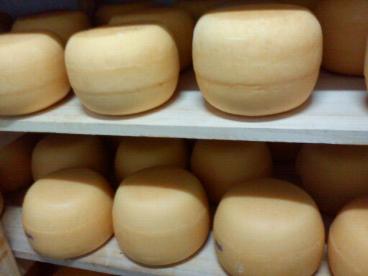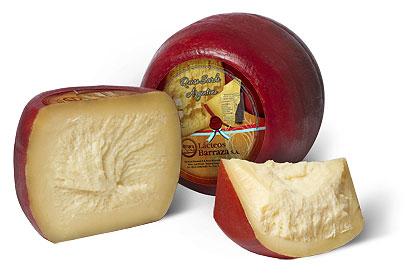
From Cabrales to Cotija, get ready to learn about Latin American cheese with Jamie Ditaranto. Starting with Spain and Portugal, across the Atlantic to the Caribbean, along the Gulf of Mexico, through the Amazon, and down the Andes, we’ll learn about the history, styles, flavors, and textures of Latin American cheeses in all their delectable glory. So, grab a cerveza and settle in for some mouth-watering reading on Cheeses of Latin America. Missed last week’s post on Brazilian cheese? Read it here.
It’s commonly said that Argentines “descended from boats,” which speaks to the country’s history of European migrants from Spain, Germany, France, Italy, etc. This is the main contributing factor to Argentina’s rich European influences, because when these immigrants came to Argentina, they brought with them the knowledge and customs from the old country, resulting in a mixture of style when it came to all things artistic and cultural. For example, in Buenos Aires it’s common to see a street with mismatched styles of architecture. This variety of style and influence is present throughout all of Argentinian culture, but when it came to cheesemaking in Argentina, the Italian immigrants took charge.

Sunset in Buenos Aires | Photo Credit: Image courtesy of Oasis Culture
Missing the delicious cheeses of their homeland, Italian immigrants in Argentina attempted to recreate some of Italy’s most iconic cheeses such as Parmigiano Reggiano, pecorino, and provolone. However, given that the cheese was being produced on an entirely new continent in a new country whose culture was being constantly shaped by the influx of immigrants, it comes as no surprise that these Italian-inspired cheeses developed a uniquely Argentine flavor.
Reggianito

Photo Credit: Image courtesy of Don Atilio
This cheese is the Argentine interpretation of Parmigiano Reggiano, originating from the Italian immigrants who wanted to make a cheese just like their homeland’s King of Cheese. The name Reggianito is diminutive of Reggiano, translated as “Little Reggiano,” and it holds true as Reggianito is produced in 6.8 kilogram wheels, which are relatively small compared to the gargantuan drums of Parmigiano Reggiano. Also unlike Parmigiano, which is aged for up to 2 years, Reggianito is only aged for 5–6 months.

Photo Credit: Image courtesy of Quilla Pampa
This cheese is the most exported cheese in Argentina and stirred up some controversy as it was being sold in the US as Parmesan. Due to this, among other things, it was responsible for Parmigiano Reggiano receiving PDO status. Italian cheesemakers feared the Reggianito would become a serious threat to their export market. The cheeses are similar, but not exactly the same.
Reggianito is a very hard and granular cow’s milk cheese, typically used for cooking or grating over pasta dishes. It’s salty with a “rich and undeniably copious flavor” and becomes creamy when heated. Unlike Parmigiano Reggiano, the salt does not crystalize, thus producing a grainy texture when broken. But just like its parent-cheese, it’s perfect for grating over pasta.
Sardo

Photo Credit: Image courtesy of Agroads
Just as Reggianito is an interpretation of Parmigiano Reggiano, Sardo is an interpretation of pecorino. However, the main difference between the two is that instead of sheep’s milk, Argentine Sardo is made with cow’s milk.

Photo Credit: Image courtesy of Barraza
With a taste that is not overwhelming but rather hearty and slightly salty, Sardo is a semi-hard granular cheese. As it ripens this pale yellow cheese turns dry and crumbly, making it perfect for grating. When the cheese is younger, it has a smoother texture. It’s made into 6-pound wheels and aged for 90 days.
Provoleta

Photo Credit: Image courtesy of Seashells and Sunflowers
As you might be able to figure out by the name, Provoleta is the Argentine variant of Italian provolone. It is a cow’s milk cheese with a semi-hard springy texture, much like the original. However what makes Provoleta so unique is the way in which it is traditionally eaten in Argentina.

Photo via My Beautiful Air
It’s typical to grill small discs of Provoleta as an appetizer while barbecuing, before eating the meat. This cheese is perfect for grilling because it keeps its shape and really holds onto that smokey flavor from the grill. It’s typically seasoned with a mix of spices and herb oil called Chimichurri and served with toasted bread.
The shape and thickness of the Provoleta is what makes it perfect for grilling. Joseph Gionnfrido of Prime Cuts explains:
“The provolone is sliced into ½-inch-thick discs, coated lightly with vegetable oil, and then over a hot and clean fire is grilled for anywhere from 15 seconds to a full minute to achieve a crisp grill-marked surface. The density and hardness of the cheese allow it to be grilled without melting through the grates, and also play a role in the ultimate goal of achieving melted cheese with a crispy surface.”
This tasty treat is the perfect flavorful appetizer to warm up the palate before a delicious Argentine barbecue!
Comment to Win
What is your favorite Argentine cheese? Do you have a favorite cheesy Argentine dish? Tell us what it is in the comments below for a chance to win a copy of culture’s Best Cheeses of 2014 issue. Post your comments by 11:59 p.m. on Monday, November 17, 2014 for a chance to win. You must be located within the continental US to be eligible. Good luck!
Photo Credit: Featured image courtesy of Agora Que Sou Casado



Are you aware of a cheese called pecorino argentino
Sardo is the best!
Especially as it gets matured.
I love reggianito!
I don’t, but the melty provoleta looks delish!